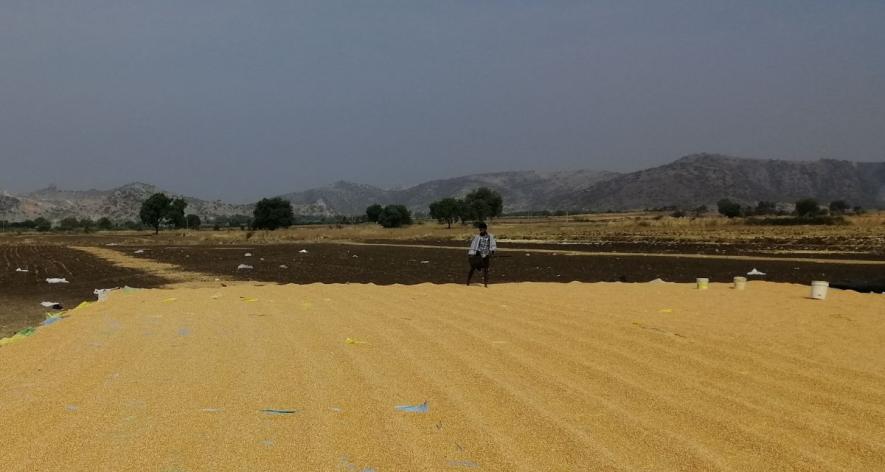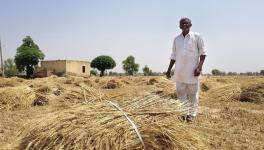Maize helps Anantapur farmers decode the climate change maze

Maize fields on the outskirts of Bommanahal (Photo - Paul Babu, 101Reporters).
Anantapur, Andhra Pradesh: "Irregular rains and long dry spells began to fail our crops nearly 15 years ago. Farming felt like a game of luck. However, after taking up maize, things changed. It requires less water, withstands any weather and gives good yields. Even if rains are erratic, we do not face big losses. Maize is a major poultry feed, so its demand naturally gives us good prices. Most of us do not even take loans for maize,” said Vadde Uligappa (55), a farmer cultivating maize since 2012 and hailing from Putlur mandal of Anantapur district in Andhra Pradesh.
The farmers of 36 villages across Bommanahal, D. Hirehal, Putlur, Peddavadugur, Vidapanakal, Tadipatri, Kundurpi and Kanekal mandals mainly grow paddy and maize. "Those with borewells sometimes go for groundnuts, chillies or cotton, and a few even try sugarcane. However, all these need plenty of water and are not climate-smart like maize," added Uligappa.
The average annual temperature in Anantapur district increased from 27.3°C in 2014 to 28°C in 2024. Peak summer temperatures, which ranged between 30°C and 35°C in 2014, soared to 44.7°C in 2024. This sharp rise has been impacting agriculture, water availability and public health, making climate adaptation strategies essential.
“Now, almost everyone is including maize as a main crop — it is profitable and reliable," added Gudipati Nettekanteiah (54) from Uddehal and K Mallikarjuna (40) from Bommanahal. According to Assistant Statistics Officer M Parvathappa, 702 acres of maize were insured in Bommanahal mandal by 350 farmers during the kharif season, while 333 acres were insured by 107 farmers in the rabi season for 2024-2025.
According to Anantapur’s official website, the district receives an average annual rainfall of 552 mm. “Maize is a highly water-efficient crop, requiring only 500 to 600 mm of water per growing season, whereas paddy consumes 1,240 mm. Simply put, the amount of water needed for one acre of paddy can conveniently support one hectare [2.47 acres] of maize in black cotton soil and two acres in red soil,” a deputy director with the Andhra Pradesh State Agriculture Department told 101Reporters over the phone, on condition of anonymity.
“Earlier, we used to grow maize as an intercrop during the kharif season to efficiently manage water allocated from River Tungabhadra for both paddy and maize. Now we grow maize twice and paddy once a year,” said farmer H Prem Kumar (44) from Devagiri. In the kharif season, 7.32 TMC of Tungabhadra water is allocated for 26 villages across Bommanahal, D. Hirehal, Kanekal, Vidapankal and Uravakonda mandals to irrigate 35,541 acres.
Low investment, high returns
Traditionally, farmers of drought-prone Anantapur district cultivated paddy and groundnut. Maize cultivation began in a small way in 1998, after farmers learnt about the concept of climate change from fertiliser representatives, who also explained to them why maize was farmer-friendly and profitable. This gradually led to increased maize production.
However, since paddy is a traditional crop and a status symbol for farmers, those with over 10 acres and access to borewells continued to grow it. If they have 10 acres, they will most likely grow paddy on seven and maize on three acres. Small farmers also grew paddy in the kharif season for their own consumption along with maize.
Farmer Chennareddy Gopal (48) from Bommanahal used to cultivate paddy thrice a year before the harsh reality of climate change began to manifest. He used to get Rs 22 to 23 per kg of the produce, for which the present rate is Rs 22.50 to 24 per kg. Maize also fetches similar rates these days, with current prices ranging from Rs 22.50 to Rs 25 per kg.
“Even when I was 12, maize was sold at Rs 500 per quintal. Even then, it was profitable. I have never faced losses with this crop,” stated Yerragunta Swamylinga (46), a tenant farmer from Putlur, who cultivates eight acres in Devagiri.
K Anand, a local leader of YSR Congress Party in Devagiri, agreed that he has never heard of farmers facing losses with maize in the 30 years of his farming journey. “We grow it at least twice in rabi,” he added.
“Maize yields better in rabi than in kharif, even though it is a perennial and non-traditional crop. Black cotton soil enhances the yield due to its water retention capacity, whereas red soil lacks water retention capacity,” Sheik Mahmood Pasha, Telangana State Green Ranger coordinator and sustainability activist, told 101Reporters.
“Just watering the land once or twice a month is enough. Even if we invest Rs 30,000 per acre, we still make at least Rs 30,000 in profit after all the expenses,” confirmed farmer K Vijayakumar (32) from Bommanahal.
Chennareddy Basavaraju (51) from Bommanahal cultivates maize on 70 acres. “Maize needs less investment, but gives higher profits. Plus, it grows in any climate. Most of us grow it twice in kharif and once in rabi, while those with borewells grow it twice in rabi and paddy twice in kharif. Our yields range from 25 to 40 quintals per acre. For paddy, we get five to 35 quintals per acre,” Basavaraju explained.
While investment costs of maize range between Rs 20,000 and 30,000 per acre, farmers report earning up to Rs 50,000 per acre. Poultry farm owners procure maize directly from growers at reasonable prices. As for paddy, the total investment is between Rs 30,000 and 40,000, while earnings range from Rs 50,000 to 70,000, and sometimes Rs 80,000, depending on the varieties and market conditions.
"For paddy, we need to keep the field watered continuously from two weeks before sowing until harvest. But with maize, we can grow it even without tilling the land," said Gopal.
Comparing the water requirements of paddy and maize, Dr G Raghunadha Reddy, Principal Scientist (Agricultural Economics), Acharya N G Ranga Agricultural University, Guntur, told 101Reporters over the phone that maize requires 90% less water and 70% less electricity (to pump water) compared to paddy cultivation.
However, maize is prone to damage if overwatered, especially within the first 40 days. Agricultural officials recommend zero-tillage methods, which save 15 to 20 days in time and investment, proving especially beneficial in drought-prone conditions.
Rising demand
The maize crop's low investment, minimal pest risk, reduced labour requirement, lower water consumption, resistance to adverse weather and a short 100-day harvest period make it more profitable than traditional commercial crops. As per the 2022-23 data from the Directorate of Economics and Statistics, Anantapur district recorded a total cereal and millet production of 2,74,397 tonnes, with maize alone accounting for 1,61,542 tonnes. In fact, maize production surpassed the combined output of all millets in the district.
According to the Andhra Pradesh government, 1,93,350 farmers insured 3,44,159 acres of maize during the 2024 kharif season, while 2,06,121 farmers insured 4,37,710 acres in the rabi season.

A farmer sun-dries maize on black cotton soil in Bommanahal (Photo - Paul Babu, 101Reporters)
"The poultry sector alone accounts for more than half of the country's domestic maize consumption. The demand has been on the rise since 1998 and is expected to remain stable as long as key dependent industries of poultry, cattle feed and alcoholic beverages continue to thrive," Dr K Bhargavi, Principal Scientist, Agricultural Research Centre, Reddipalli, told 101Reporters over the phone. She added that Karnataka, Andhra Pradesh, Telangana, Gujarat, Punjab, Haryana, Bihar and West Bengal were the major maize consumers.
According to Bhargavi, MM9344 (DMH 192) is predominantly cultivated during the kharif season in Andhra Pradesh, Tamil Nadu, Karnataka and Maharashtra, while Bisco X 5129 is widely preferred for rabi. "Since maize hybrids perform differently under varying climatic conditions, scientists regularly visit fields to assess regional adaptability and recommend the most suitable varieties," she added.
Maize cultivation primarily relies on three types of cultivars — traditional varieties, high-yielding varieties and hybrids. Almost all farmers prefer hybrids, which are exclusively produced by private agencies. “The government has no direct role in increasing maize production since farmers themselves are driving its expansion due to its profitability," the deputy director of agriculture remarked.
Reddy explained that the government does not intervene by establishing procurement centres since 62% of maize is primarily used for poultry and cattle feed, while only 8% is used for human consumption. He added that maize is rightly called the ‘Queen of Cereals’ because every part of the plant — grain, leaves, stalk, tassel and cob — holds economic value.
Reddy further noted that representatives of fertiliser agencies play a key role in promoting maize cultivation, as modern maize cultivars offer higher yields, disease resistance and adaptability to diverse soil and climate conditions. "On average, these high-yielding varieties have improved maize productivity by 25-30% compared to traditional cultivars.”
"Since maize hybrids are disease-resistant, a family of four can easily manage 10 acres of maize. Otherwise, we would have to spend heavily on pesticides and hire sprayers, paying around Rs 500 per acre. Even weeds do not grow much with hybrids," said Gopal.
According to the ICAR-Indian Institute of Maize Research, India ranks fourth globally in maize cultivation area and seventh in production. Among cereals, maize has exhibited the highest growth rate in both area and productivity, increasing by over 50 kg/ha annually since 2010, making it the fastest-growing food crop in India.
The Crop Outlook Report on Maize by the Centre for Agriculture and Rural Development Policy Research (CARP), ANGRAU, for 2023-24 termed maize as India’s third most important cereal crop after rice and wheat, contributing 10% of total food grain production. According to the Department of Economics and Statistics, Andhra Pradesh (DESAP), the state ranks 13th in maize cultivation area, covering 2.91 lakh hectares, with a production of 19.04 lakh tonnes (5.34% of India’s total) at a productivity of 6,543 kg per hectare in 2023-24.
The minimum support price for maize in 2024-25 is set at Rs 2,225 per quintal, marking an increase of Rs 135 per quintal from the previous year. Over the past three decades, maize cultivation in Andhra Pradesh has witnessed an exponential rise, with the area increasing by 838.71% (Compound Annual Growth Rate: 8.68%), production by 2,922.2% (CAGR: 12.35%), and productivity at a CAGR of 3.39%.
Paul Babu is a freelance journalist and a member of 101Reporters, a pan-India network of grassroots reporters.
Get the latest reports & analysis with people's perspective on Protests, movements & deep analytical videos, discussions of the current affairs in your Telegram app. Subscribe to NewsClick's Telegram channel & get Real-Time updates on stories, as they get published on our website.
























